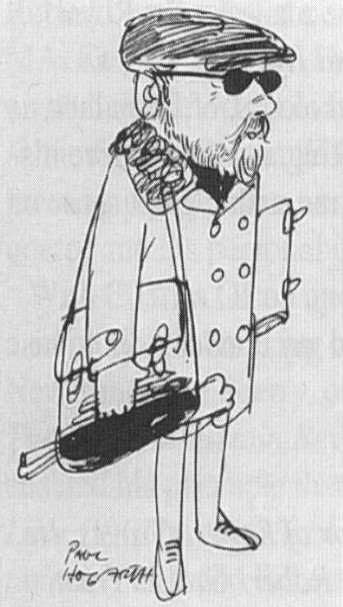|
Search Help |
|
Links Robert Graves Website Other RG Resources |

Obituaries
Paul Hogarth, OBE, RA (1917-2001)
 It was with sorrow that we heard the sad news that
It was with sorrow that we heard the sad news that
Paul Hogarth died suddenly on 27 December 2001. He was a member of the Robert Graves Society and a contributor to this journal. He died while in full creative swing.
Paul's relationship with Robert Graves went back to April 1963, when they began their collaboration in Majorca Observed (Cassell, 1965). Thereafter, Paul was a frequent visitor to Deyå, and in the late 1960s bought a house in the Clot part of the village, He lived there for several years with his third wife, Pat Douthwaite, and son Toby. In the early 1970s he illustrated five of Robert's poems, which were published as the magnificent Deyå: A Portfolio (Motif, 1972). Readers are referred to the previous issue of Gravesiana, where Paul describes their warm relationship.
Paul was born in Kendal, in what is now Cumbria, in 1917. His family soon moved to Manchester, where his father ran a butcher's shop. He began drawing (on his father's wrapping paper) when still a child. In his early teens he discovered modern paintings and drawings in the Manchester art galleries. After taking evening art classes, Paul was encouraged in 1933 to sit the entrance exam for the Manchester School of Art. He gained a scholarship and, three years later, moved to St Martin's School of Art in London.
As a young man Paul joined the Communist Party and in 1936 briefly joined the International Brigade to fight Franco in the Spanish Civil War. During the Second World War he worked on propaganda, designing posters and leaflets. In 1942 he married Doreen Courtman, the first of his four wives. At the end of the war he received commissions to draw the reconstruction of Europe. On one of the early trips he accompanied his friend Ronald Searle, who would later also illustrate Robert Graves - his translation of The Iliad, The Anger ofAchilles (Doubleday 1959).
Paul began to illustrate books, teach, and publish books of his own. While teaching in the United States he became disillusioned with Communism and dropped it completely when he saw the results on a working trip to Russia in 1967. When he came to the island to work on Mallorca Observed, he had just finished Brendan Behan's Island: An Irish Sketchbook (1962). Later works included Graham Greene Country (1986), which covered more than twenty countries, and The Mediterranean Shore (1988), devoted to Lawrence Durrell's Provence.
In 1974 Paul was elected an associate member of the Royal Academy, and
became a full member in 1984. In 1982 he became honorary president of the Association of Illustrators. He was awarded the OBE in 1989, and an honorary doctorate by Manchester University in 1999.
Four months before he died, Paul sent me the video he made for the Royal Academy collection 'Spirit of the Place', The Art ofPaul Hogarth, OBE, RA.
In the film he is seen producing three fascinating watercolours, of Fornalutx, Lluchalcari and Deyå respectively. As we see him working and can admire his technique, he talks of Robert Graves and others. It left me with a great sense of well-being.
May I, on behalf of the Robert Graves Society, extend my condolences to his wife Diana and to his son Toby.
William Graves is a geologist and the literary executor ofRobert Graves. He is a member ofthe committees of the St John's College Robert Graves Trust, Oxford, and the Fundaciö Robert Graves, Mallorca.